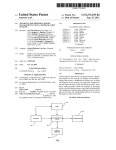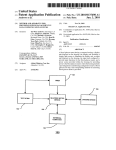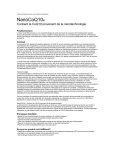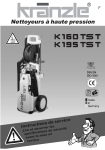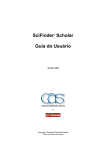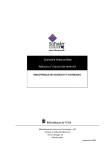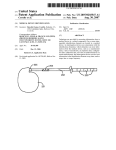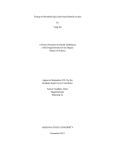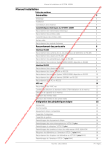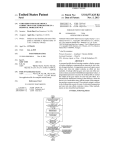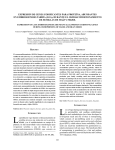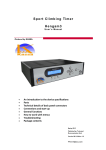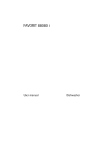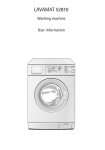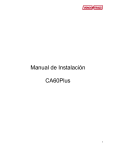Download Apparatus for providing power management in data communication
Transcript
USOO8906307B2 (12) United States Patent (10) Patent No.: Andrews et a]. (54) (45) Date of Patent: APPARATUS FOR PROVIDING POWER (58) Field of Classi?cation Search SYSTEMS USPC _ ....................................................... .. 422/681 See application ?le for complete search history. Inventors: Tae Wan Andrews, San D1ego, CA (US); Stephen C. Bubrick, Orinda, CA (US); Sheilah S. Estoesta, Mountain View, CA (US); Brad D. Etter, (56) References Cited U.S. PATENT DOCUMENTS 3 930 493 A 1/1976 W_11_ Alameda, CA (US); Hyoung Yoon Park, Duluth, GA (US); Gene Ming Pon, San ’ Jose, CA (Us); Christopher“ r 1 lamson 4,018,547 A Reggiardo, Castro Valley, CA (US); Heber Saravia, Daly City, CA (US) 4/1977 Rogen (continued) FOREIGN PATENT DOCUMENTS (73) Assignee: Abbott Diabetes Care Inc., Alameda, CA (Us) ( * ) Notice: Dec. 9, 2014 USPC ....................................................... .. 422/681 MANAGEMENT IN DATA COMMUNICATION (75) US 8,906,307 B2 EP 0455455 11/1991 EP 0878707 11/1998 Subject to any disclaimer, the term of this (continued) patent is extended or adjusted under 35 OTHER PUBLICATIONS U.S.C. 154(b) by 117 days. “An (21) Appl. No.: 12/859,081 (22) Filed: Electrochemical Aug. 18, 2010 (65) Slow Flow Meter” http://goreocean. washingtonedu/researchj slow ?ow meter.html, Feb. 10, 2005, 3. (Continued) Prior Publication Data Us 2010/0312085 A1 Primary Examiner * Sam P Siefke (74) Attorney, Agent, or Firm *Edward J. Baba; Shweta Chandra; BoZicevic, Field & Francis LLP Dec' 9’ 2010 Related US. Application Data _ _ _ _ (57) (63) JContmuatlon of app11catlon No. 10/861,626, ?led on un. 4, 2004, now Pat. No. 8,071,028. (60) . . . . (51) (2006-01) (2006-01) (2006-01) 19 Claims, 6 Drawing Sheets (2013.01); A61B 2560/0209 (2013.01) ‘ V USER / 101 /104 V > GLUCOS E METER TEST STRIP DEVICE / . . glucose test strip, and corresponding methods of measuring blood glucose meter is provided. CPC ............. .. C12Q 1/54 (2013.01); A61B 5/]4532 102 . umt dlsposed on the housmg, the dlsplay un1t 1nclud1ng a display light source to illuminate the display unit, an input unit disposed on the housing, the input unit con?gured to provide input functions for the blood glucose meter, and a power source provided Within the housing for providing power to the blood glucose meter, Where the housing includes a port integrated on said housing con?gured to receive a blood Provisional application No. 60/478,436, ?led on Jun. 12, 2003. Illt- ClG01N 33/00 C1 2Q 1/54 A613 5/145 (52) US. Cl. ABSTRACT A blood glucose meter having a compact housing, a display 103 / A V EXTERNAL COMPUTER 105 I ‘ ‘ LANCING DEVICE US 8,906,307 B2 Page 2 (56) References Cited U.S. PATENT DOCUMENTS 4,121,282 4,439,197 4,531,235 4,866,396 4,984,581 5,004,532 5,019,974 5,051,880 5,079,920 5,081,421 5,124,661 5,207,666 5,211,371 5,211,626 5,278,997 5,325,280 5,366,292 5,391,250 5,404,585 5,507,288 5,568,400 5,575,770 5,604,404 5,622,413 5,622,482 5,645,709 5,661,643 5,695,949 5,699,243 5,703,928 5,822,715 5,848,990 5,899,855 5,913,833 6,027,459 6,027,496 6,027,692 6,059,546 6,063,039 6,067,463 6,071,249 6,071,251 6,073,031 6,077,660 6,081,104 6,085,871 6,093,156 6,129,823 6,132,371 6,144,303 6,144,922 6,155,992 6,160,449 6,162,202 6,173,160 6,175,752 6,185,452 6,206,841 6,208,894 6,242,961 6,245,060 6,248,067 6,262,708 6,283,926 6,295,506 6,298,255 6,306,104 6,312,888 6,315,721 6,368,274 6,375,638 6,377,894 6,403,944 6,417,074 6,425,829 >D 10/1978 3/1984 7/1985 9/1989 1/1991 4/1991 5/1991 9/1991 1/1992 1/1992 6/1992 5/1993 5/1993 5/1993 1/1994 6/1994 11/1994 2/1995 4/1995 4/1996 10/1996 11/1996 2/1997 4/1997 4/1997 7/1997 8/1997 12/1997 12/1997 12/1997 10/1998 12/1998 5/1999 6/1999 2/2000 2/2000 2/2000 5/2000 5/2000 5/2000 6/2000 6/2000 6/2000 6/2000 6/2000 7/2000 7/2000 10/2000 10/2000 11/2000 11/2000 12/2000 12/2000 12/2000 1/2001 1/2001 2/2001 3/2001 3/2001 6/2001 6/2001 6/2001 7/2001 9/2001 9/2001 10/2001 10/2001 11/2001 11/2001 4/2002 4/2002 4/2002 6/2002 7/2002 7/2002 Ohsawa Honda et al. Brusen Tamura Stice Hale Beckers Harm et al. Whitehead et al. Miller et al. Zelin et al. Idriss et al. Coffee Frank et al. Martin Tortola et al. Voss Cheney, II et al. Vimpari et al. Booker et al. Stark et al. Melsky et al. Sahara Kim et al. Lee Birch et al. Blaker et al. Galen et al. Eckel et al. Galloway et al. Worthington et al. Cirelli et al. Brown Elstrom et al. Shain et al. Loomis et al. Galen et al. Brenan et al. Cunningham et al. Jeng et al. Cunningham et al. Cunningham et al. Helstab et al. Wong et al. Kern Karamata Cunningham et al. Hughes et al. Dempsey et al. Federman Douglas et al. Henning et al. Klomsdorf et al. Sicurelli et al. Liimatainen Say et al. Schulman et al. Cunningham et al. Schulman et al. Liu et al. Loomis et al. Causey, III et al. Chu Cunningham et al. Heinonen et al. Cordero et al. Cunningham et al. Wong et al. Schulman et al. Van Antwerp et al. Nason et al. Deweese et al. MacKenZie et al. Kopley et al. Julien 6,427,088 6,437,379 6,438,385 6,466,807 6,471,980 6,492,180 6,506,168 6,514,460 6,522,530 6,526,298 6,540,891 6,551,276 6,558,320 6,558,321 6,560,471 6,562,001 6,564,105 6,565,509 6,565,738 6,569,157 6,571,128 6,577,899 6,582,393 6,585,644 6,586,971 6,600,997 6,615,061 6,615,074 6,641,533 6,648,821 6,659,948 6,669,669 6,679,841 6,687,546 6,692,457 6,694,191 6,702,857 6,723,072 6,730,200 6,733,446 6,740,075 6,741,877 6,752,787 6,758,810 6,764,581 6,810,290 6,811,533 6,811,534 6,813,519 6,833,540 6,835,553 6,837,858 6,840,912 6,859,831 6,862,465 6,873,268 6,931,327 6,950,708 6,958,129 6,958,705 6,974,437 6,990,372 7,003,340 7,020,508 7,024,245 7,024,249 7,041,468 7,043,287 7,067,498 7,074,307 7,081,195 7,098,803 7,108,778 7,110,803 7,123,206 7,134,999 7,136,689 7,136,704 7,153,212 7/2002 8/2002 8/2002 10/2002 10/2002 12/2002 1/2003 2/2003 2/2003 2/2003 4/2003 4/2003 5/2003 5/2003 5/2003 5/2003 5/2003 5/2003 5/2003 5/2003 5/2003 6/2003 6/2003 7/2003 7/2003 7/2003 9/2003 9/2003 11/2003 11/2003 12/2003 12/2003 1/2004 2/2004 2/2004 2/2004 3/2004 4/2004 5/2004 5/2004 5/2004 5/2004 6/2004 7/2004 7/2004 10/2004 11/2004 11/2004 11/2004 12/2004 12/2004 1/2005 1/2005 2/2005 3/2005 3/2005 8/2005 9/2005 10/2005 10/2005 12/2005 1/2006 2/2006 3/2006 4/2006 4/2006 5/2006 5/2006 6/2006 7/2006 7/2006 8/2006 9/2006 9/2006 10/2006 11/2006 11/2006 11/2006 12/2006 Bowman, IV et al. Kopley et al. Heinonen et al. Dobson et al. Sirhan et al. Brown et al. Fathallah et al. Fendrock Bang Khalil et al. Stewart et al. Mann et al. Causey, III et al. Bird et al. Heller et al. Lebel et al. Starkweather et al. Say et al. Henning et al. Shain et al. Lebel et al. Lebel et al. Sage, Jr. Lebel et al. Naffziger et al. Deweese et al. Khalil et al. Mickle et al. Causey, III et al. Lebel et al. Lebel et al. Flaherty et al. Bojan et al. Lebel et al. Flaherty Lebel et al. Brauker et al. Flaherty et al. Stewart et al. Lebel et al. Lebel et al. Shults et al. Causey, III et al. Lebel et al. Forrow et al. Lebel et al. Lebel et al. Bowman, IV et al. Lebel et al. MacKenZie et al. Han et al. Cunningham et al. Kloepfer et al. Gelvin et al. Shults et al. Lebel et al. Goode, Jr. et al. Bowman IV et al. Galen et al. Lebel et al. Lebel et al. Perron et al. Say et al. Stirovic et al. Lebel et al. Wei sner et al. Drucker et al. Khalil et al. Wolf et al. Simpson et al. Simpson et al. Mann et al. Simpson et al. Shults et al. Hess et al. Brauker et al. Shults et al. Schulman Karten et al. US 8,906,307 B2 Page 3 (56) References Cited U_S_ PATENT DQCUMENTS 7 154 398 B2 12/2006 Chen et a1, 2006/0020191 A1 1/2006 Brister et a1. 2006/0020192 2006/0036139 2006/0036140 2006/0036141 1/2006 2/2006 2/2006 2/2006 A1 A1 A1 A1 Brister et a1. Brister et a1. Brister et a1. Kamath et a1. 731862566 B2 3/2007 Qian 2006/0036142 A1 2/2006 BriSter et a1. 7 192 450 B2 3/2007 Brauker et 31‘ 2006/0036143 A1 2/2006 Brister et a1. 7’202’734 B1 7’205’409 B2 7’225’535 B2 4/2007 Raab 4/2007 Pei et 31‘ 6/2007 Feldman et 31‘ 2006/0036144 A1 2006/0036145 A1 2006/0222566 A1 2/2006 BriSter et a1. 2/2006 BriSter et a1. 10/2006 Brauker et a1. 11/2006 Fennell 732262978 B2 6/2007 Tapsak et 31‘ 2006/0247508 A1 7 258 666 B2 8/2007 Brown 2007/0016381 A1 1/2007 Kamath et a1. 732663400 B2 9/2007 Fine et 31‘ 2007/0163880 A1 7/2007 WOO et a1. 7 276 029 B2 10/2007 Goode Jr‘ et 31‘ 2007/0203966 A1 8/2007 Brauker et a1. 733102544 B2 12/2007 Brister’et 31‘ 2007/0235331 A1 10/2007 Simpson et a1. 7,344,507 B2 3/2008 Briggs et a1. ................ .. 600/583 Zoos/0021666 A1 1/2008 Goode, Jr et al 7 364 592 B2 4/2008 Carr_Brende1 et 31‘ 2008/0033254 A1 2/2008 Kamath et a1. 2008/0045824 2008/0064941 2008/0071156 2008/0083617 2008/0086042 2008/0086044 2/2008 3/2008 3/2008 4/2008 4/2008 4/2008 7’366’556 7’379’765 7’424’3 18 7’460’898 7’467’003 734713972 B2 B2 B2 B2 B2 B2 4/2008 5/2008 9/2008 @2008 @2008 12/2008 Brister et 31‘ Petisce et 31‘ Brister et 31‘ Brister et 31‘ Brister et 31‘ Rhodes et 31‘ A1 A1 A1 A1 A1 A1 Tapsak et a1. Funderburk et a1. BriSter et a1. Simpson et a1. BriSter et a1. BriSter et a1. 7 494 465 B2 2/2009 Brister et al‘ 2008/0086273 A1 4/2008 Shults et a1. 7’497’827 B2 7’519’408 B2 7’583’990 B2 3/2009 Brister et 31‘ 4/2009 Rade et 31‘ 9/2009 Goode Jr‘ et 31‘ 2008/0108942 A1 2008/0146900 A1 2008/0183061 A1 5/2008 BriSter et a1. 6/2008 Andrews et a1. 7/2008 Goode et a1. 7’591’801 B2 9/2009 Braukér et 31‘ 2008/0183399 A1 7/2008 Goode et a1. 7’599’726 B2 10/2009 Goode Jr‘ et 31‘ 2008/0188731 A1 8/2008 BriSter et a1. 7’613’491 B2 11/2009 Boock’et 31‘ 2008/0189051 A1 8/2008 Goode et a1. 7’615’007 736322228 2001/0023095 2001/0024864 B2 B2 A1 A1 11/2009 12/2009 9/2001 9/2001 Shults et 31‘ Brauker et 31‘ Kopley et al‘ Kopley et al‘ 2008/0194935 2008/0194936 2008/0194937 2008/0194938 A1 A1 A1 A1 8/2008 8/2008 8/2008 8/2008 BriSter et a1. Goode et a1. G0_0de et a1. anter et a1. 2002/0118090 2002/0193679 2003/0023317 2003/0032874 2003/0060765 2003/0078560 A1 A1 A1 A1 A1 A1 8/2002 12/2002 1/2003 2/2003 3/2003 4/2003 Park et al‘ 2008/0195232 Zoos/0195967 Zoos/0197024 2008/0200788 2008/0200789 Zoos/0200791 A1 8/2008 Carr-Brendel et a1. Malave et a1. Brauker et a1. Rhodes et 31‘ Campbell et a1, Miller et a1. A1 A1 A1 A1 A1 8/2008 8/2008 8/2008 8/2008 8/2008 Goode et al SlmPSOIl er al~ Brister et a1. Brister et a1. Simpson er al~ 2003/0107487 2003/0198558 2003/0212346 2003/0217966 2004/0011671 2004/0019321 2004/0045879 2004/0064133 2004/0132220 2004/0133092 2004/0152622 2004/0186362 2004/0186365 2004/0199059 2005/0031689 2005/0038680 2005/0043598 2005/0053365 2005/0065464 Zoos/0090607 2005/0112169 2005/0143635 2005/0176136 Zoos/0182306 2005/0187720 A1 A1 A1 A1 A1 A1 A1 A1 A1 A1 A1 A1 A1 A1 A1 A1 A1 A1 A1 Al A1 A1 A1 Al A1 6/2003 10/2003 11/2003 11/2003 1/2004 1/2004 3/2004 4/2004 7/2004 7/2004 8/2004 9/2004 9/2004 10/2004 2/2005 2/2005 2/2005 3/2005 3/2005 4/2005 5/2005 6/2005 8/2005 8/2005 8/2005 Korman et 31‘ Nason et 31‘ Yuzhakov et a1. Tapsak et al‘ Shults et a1, Sage et a1, shuns et al‘ Miller et a1, Fish Kain Keith et a1, Brauker et 31‘ Yin et a1, Brauker et 31‘ Shults et a1, McMahon Goode, Jr. et a1. Adams et a1, Talbot et a1, Tapsak et al‘ Brauker et 31‘ Kamath et al‘ Burd et al‘ Sloan Goode Jr‘ et 31‘ 2008/0208025 2008/0214915 Zoos/0214918 2008/0228051 2008/0228054 2008/0242961 2008/0262469 2008/0275313 2008/0287764 2008/0287765 2008/0287766 2008/0296155 2008/0306368 2008/0306434 2008/0306435 2008/0306444 2009/0012379 2009/0018424 2009/0030294 2009/0036758 2009/0036763 2009/0043181 2009/0043182 2009/0043525 2009/0043541 A1 A1 A1 A1 A1 A1 A1 A1 A1 A1 A1 A1 A1 A1 A1 A1 A1 A1 A1 A1 A1 A1 A1 A1 A1 8/2008 9/2008 9/2008 9/2008 9/2008 10/2008 10/2008 11/2008 11/2008 11/2008 11/2008 12/2008 12/2008 12/2008 12/2008 12/2008 1/2009 1/2009 1/2009 2/2009 2/2009 2/2009 2/2009 2/2009 2/2009 Shults et a1. Brister et a1. anter et al~ Shults et a1. Shults et a1. Brister et a1. Brister et a1. Brister et a1. Rasdal et a1. Rasdal et a1. Rasdal et a1. Shults et a1. Goode et a1. Dobbles et a1. Kamath et a1. Brister et a1. Goode et al~ Kamath et a1. Petisce et a1. Brauker et a1. Brauker et a1. Brauker et a1. Brauker et a1. Brauker et a1. Brauker et a1. 2005/0192557 Zoos/0235732 2005/0245795 2005/0245799 2005/0249606 2006/0001551 2006/0015020 2006/0016700 2006/0019327 2006/0020186 2006/0020187 2006/0020188 2006/0020189 2006/0020190 A1 A1 A1 A1 A1 A1 A1 A1 A1 A1 A1 A1 A1 A1 9/2005 10/2005 11/2005 11/2005 11/2005 1/2006 1/2006 1/2006 1/2006 1/2006 1/2006 1/2006 1/2006 1/2006 Braukér et 31‘ Rush Goode Jr‘ et 31‘ Braukér et 31‘ Rush Kraft et 31, Neale et a1. Brister et a1. Brister et a1. Brister et a1. Brister et a1. Kamath et a1. Brister et a1. Kamath et a1. 2009/0043542 2009/0045055 2009/0062633 2009/0062635 2009/0076356 2009/0076360 2009/0076361 2009/0099436 2009/0124877 2009/0124878 2009/0124879 2009/0124964 2009/0131768 2009/0131769 A1 A1 A1 A1 A1 A1 A1 A1 A1 A1 A1 A1 A1 A1 2/2009 2/2009 3/2009 3/2009 3/2009 3/2009 3/2009 4/2009 5/2009 5/2009 5/2009 5/2009 5/2009 5/2009 Brauker et a1. Rhodes et a1. Brauker et a1. Brauker et a1. Simpson et a1. Brister et a1. Kamath et a1. Brister et a1. Goode, Jr. et a1. Goode et a1. Brister et a1. Leach et a1. Simpson et a1. Leach et a1. US 8,906,307 B2 Page 4 (56) 2009/0131776 2009/0131777 2009/0137886 2009/0137887 2009/0143659 2009/0143660 2009/0156919 References Cited 2009/0299155 A1 12/2009 Yang et al. US, PATENT DOCUMENTS 2009/0299156 A1 2009/0299162 A1 2009/0299276 A1 12/2009 Simpson et al. 12/2009 Brauker et al. 12/2009 Brauker et al. A1 A1 5/2009 Simpson et al. 5/2009 Simpson et a1. 2009/0156924 2009/0163790 2009/0163791 2009/0178459 2009/0182217 2009/0192366 2009/0192380 2009/0192722 A1 A1 A1 A1 A1 A1 A1 A1 A1 A1 A1 A1 A1 5/2009 5/2009 6/2009 6/2009 6/2009 6/2009 6/2009 6/2009 7/2009 7/2009 7/2009 7/2009 7/2009 2009/0192745 2009/0192751 2009/0203981 2009/0204341 2009/0216103 2009/0240120 A1 A1 A1 A1 A1 A1 7/2009 Kamath et al. 7/2009 Kamath et al. 8/2009 Brauker et 31‘ Shariati et al. Shariati et al. Li et al. Brister et al. Brister et al. Shariati et al. Brister et al. Brister et al. Li et al. Li et al. Mensinger et al. Shariati et al. Shariati et al. 8/2009 Brauker et 31‘ 8/2009 Brister et al. 9/2009 MenSingeT et al~ FOREIGN PATENT DOCUMENTS EP EP JP JP W0 W0 W0 W0 W0 W0 W0 0543916 1130638 2001177423 2001056673 WO 02084860 WO 2004028337 WO 2005101994 WO 2006079114 WO 2006110913 WO 2006113408 WO 2006113521 7/2001 9/2001 6/2001 11/2001 10/2002 4/2004 11/2005 7/2006 10/2006 10/2006 10/2006 Barbosa, R. M. (1996) “Electrochemical Studies of Zinc in Zinc Insulin Solution”, Journal of the Royal Society of Chemistry. CAPLUS Abstract. Analyst 121(12): 1789-1793. Bard, A. J ., et a1. (2001) “Methods Involving Forced Convectioni 2009/0240128 A1 9/2009 Mensinger et al~ Hydrodynamic Methods”, Electrochemical MetliodsiFundamen 2009/0240193 A1 9/2009 Mensinger et al. tals and Applications. 331367‘ 2009/0242399 A1 10/2009 Kamath et al. . . “ . . ,, 2009/0242425 A1 10/2009 Kamath et al‘ Kissinger, P. T. (1996) Introduction to Analog Instrumentation , 2009/0247855 A1 10/2009 Boock et 31‘ Laboratory Techniques in Electroanalytical Chemistry, Second Edi 2009/0247856 A1 2009/0287073 A1 2009/0287074 A1 10/2009 Boock et a1. 11/2009 Boock et a1. 11/2009 Shults et al. tion, Revised and Expanded, Jan 165-194 * cited by examiner US. Patent Dec. 9, 2014 US 8,906,307 B2 Sheet 1 0f 6 02N6US(M1D A,m w: wKOhDJmUE \lmi l! 5E.wWa \‘New or mFMDQE US. Patent Dec. 9, 2014 Sheet 3 0f6 US 8,906,307 B2 301 307 302 303 —V@ 305 304 ‘6' 306 309 308 310 FIGURE 3 US. Patent Dec. 9, 2014 US 8,906,307 B2 Sheet 4 0f 6 41 413 F4IGUBRE 410 414 4089 404 405 302 406 .vEDEE 403 401 402 F4IGUARE US. Patent Dec. 9, 2014 Sheet 5 0f6 DETECT TEST STRIP INSERTION 501 M VERIFY INSERTED TEST STRIP AND PERFORM 5°? SELF TEST I TURN ON DISPLAY AND PROMPT USER TO 5°3 A ENTER OR CONFIRM TEST STRIP CALIBRATION coDE <-——-———Mo 504 r PROMPT USER TO APPLY BLOOD SAMPLE T0 TEST STRIP $05 AMPLE DETECTION COMPLETE? YES sue ' —/\ SIGNAL TO USER THAT sAMPLE FILL ls COMPLETE AND GLUCOSE LEVEL IS now BEING ANALYZED I 507 DETERMINE GLUCOSE VALUE CORRESPONDING TO DETECTED BLOOD SAMPLE sea 7 /\ DISPLAY DETERMINED GLUCOSE VALUE AND STORE m MEMORY FIGURE 5 US 8,906,307 B2 US. Patent Dec. 9, 2014 Sheet 6 0f6 US 8,906,307 B2 10 % 50% CDyuctlye %\A 0 10 % 50%4 0% 6FIGURE US 8,906,307 B2 1 2 APPARATUS FOR PROVIDING POWER MANAGEMENT IN DATA COMMUNICATION SYSTEMS of light intensity by, for example, adjusting the duty cycle and the period during which the light source is con?gured to be RELATED APPLICATION Additionally, in accordance with a further aspect of the invention, the blood glucose meter may include a numerically displayed clock with a date display which may be visible turned on. when the meter is not in use. Moreover, the clock feature in yet a further embodiment of the present invention may This application claims priority under 35 USC §ll9 to Provisional Patent Application No. 60/478,436 ?led on Jun. include an alarm which would allow the users to set alarm 12, 2003, entitled “Method and Apparatus for Providing Power Management in Data Communication Systems”, the disclosure of which is incorporated herein by reference for all reminder for performing blood glucose level testing, where purposes. auditory alarm, a visual alarm alert, and a vibration alert mode. Indeed, a blood glucose meter in accordance with one embodiment of the present invention includes a compact housing for a blood glucose meter, a display unit disposed on the alarm feature may include one or a combination of an BACKGROUND The present invention relates to data monitoring systems. More speci?cally, the present invention relates to portable the housing, the display unit con?gured to display informa tion related to the blood glucose meter, an input unit disposed analyte monitoring systems. More speci?cally, the present on the housing, the input unit con?gured to provide input invention relates to a compact, blood glucose meter for use in a glucose monitoring system to self-monitor glucose level in 20 provided within the housing for providing power to the blood glucose meter. The display unit may include one of a liquid crystal display whole blood, as an aid to disease management, and also by healthcare professionals as an aid to monitor the effectiveness of diabetes treatment. SUMMARY OF THE INVENTION 25 The market for glucose monitoring systems in the United The light source in one embodiment may be con?gured to 30 length of approximately 570 nanometers. In one embodiment, the light source may include a light emitting diode (LED), and more speci?cally, a yellow-green 35 glucose levels. cose test strip. 40 device to be carried around or used and operated by the patients, especially children. In view of the foregoing, in accordance with the various embodiments of the present invention, there is provided a blood glucose meter which is designed to be substantially more compact than presently available commercial blood glucose meters, which con?guration that is much more ame nable to usage and portage by younger diabetic patients such as children. LED. In a further embodiment, the housing may include a port integrated on the housing con?gured to receive a blood glu While miniaturization has been a factor of recent designs in the glucose monitoring systems and the glucose meters, the physical constraints of the components of such systems have established a certain size limitation. As such, the larger and bulkier the device, the less desirable and convenient for the be pulsed at a frequency greater than 60-100 Hertz. Moreover, the light source may further con?gured to have a peak wave glucose using glucose monitoring systems. One group of such rapidly increasing segment of the population is children with diabetic conditions who are advised to monitor their blood (LCD), a touch sensitive screen, and a plasma display unit. The display unit may also include a light source to illumi nate the display unit, where the light source may be con?g ured to provide a backlight function and a ?ashlight function of the display unit. States as well as globally is rapidly increasing, as better health education and early detection of diabetic conditions through regular check ups have increased the percentage of the dia betic population who undertake the task of monitoring their diet and daily activities based on the detected level of blood functions for the blood glucose meter, and a power source The port may include a light source that may be con?gured to substantially illuminate the port to assist in the insertion and/or removal of the blood glucose test strip. In yet another embodiment, the display unit may be con ?gured to illuminate upon detection of a blood glucose test strip insertion into the port. Further, the display unit may be 45 50 con?gured to remain illuminated until the test strip is removed from the port. The input unit in one embodiment may include an on/off switch. A blood glucose meter in accordance with another embodi ment includes a compact housing for a blood glucose meter, non-daylight times and so on, as well as a light source to guide a display unit disposed on the housing, the display unit including a display light source to illuminate the display unit, an input unit disposed on the housing, the input unit con?g ured to provide input functions for the blood glucose meter, and a power source provided within the housing for providing power to the blood glucose meter, where the housing includes the insertion and removal of the test strip, which may include the usage of a light emitting diode. Indeed, as the light source glucose test strip. More speci?cally, in one aspect of the invention, the blood glucose meter is con?gured to include a LCD backlight and a ?ashlight features which will assist the patient in reading the metered glucose level in low-light testing areas such as in theaters, low ambient light restaurants, areas, outdoors during 55 a port integrated on said housing con?gured to receive a blood (e.g., the LED) may be pulsed and still display substantially the same light output as one which is turned on in steady state, The port in one embodiment may include a port light 60 the battery life of the glucose meter device may be prolonged since the pulsed LED light source requires signi?cantly less power (and thus draining the battery at a much slower rate) source, the port light source con?gured to substantially illu minate the port to assist in the insertion and/or removal of the blood glucose test strip. Additionally, in an alternate embodiment, the port light unit of the glucose meter device may be con?gured to control source may be integrated with the display light source. A method of measuring blood glucose level in accordance with yet another embodiment of the present invention the switching on and off of the light source as well as the level includes the steps of providing a compact housing, disposing than when the LED light source is maintained at the on position. Indeed, in one embodiment, the central processing 65 US 8,906,307 B2 3 4 a display unit on the housing, the display unit including a or laptop computer for use by the user’s physician or care display light source to illuminate the display unit, disposing an input unit on the housing, the input unit con?gured to provider (or the user herself), a personal digital assistant (PDA) which is operatively con?gured to store and/or further, provide input functions for the blood glucose meter, provid to communicate with a data network to transmit and receive ing a power source within the housing for providing power to patient data related to the glucose level detected from the collected blood sample, for further diagnosis, analysis and the the blood glucose meter, where the housing includes a port integrated on said housing con?gured to receive a blood glu like. In one embodiment, the user 101 may provide the con?gu ration parameters as well as calibration code to the glucose meter device 103, while the glucose meter device 103 may be con?gured to output signal prompts to the user 101 such as to indicate a sample ?ll signal and a sample result signal, and cose test strip. These and other features and advantages of the present invention will be understood upon consideration of the fol lowing detailed description of the invention and the accom panying drawings. further, to output display the resulting measured blood glu cose level from the sampled blood from the user 101. Fur INCORPORATION BY REFERENCE thermore, after the user 101 is lanced with the lancing device 104 to generate suf?cient amount of sample blood, the test Applicants herein incorporate by reference application Ser. strip 102 is provided in contact thereto (i.e., to the sample blood) while the test strip 102 is operatively coupled to the No. 09/434,026 ?led Nov. 4, 1999 entitled “Small Volume In Vitro Analyte Sensor and Methods”, application Ser. No. 09/753,746 ?led on J an. 2, 2001 entitled “Analyte Monitoring Device and Methods of Use”, and Application Nos. 60/437, 374 ?led Dec. 31, 2002 and application Ser. No. 10/745,878 20 glucose meter device 103. In this manner, the glucose meter device 103 may in one embodiment be con?gured to alert the user that the amount of blood sample on the test strip 102 is suf?cient to determine the corresponding blood glucose level. In one aspect of the present invention, the glucose meter ?led Dec. 26, 2003 both entitled “Continuous Glucose Moni toring System and Methods of Use”, each assigned to the Assignee of the present application for all purposes. device 103 may be con?gured to make clinical measurements 25 BRIEF DESCRIPTION OF THE DRAWINGS of glucose in whole blood in the range for approximately 20 to 500 mg/dL. Furthermore, as discussed in further detail below, the glucose meter device 103 may be con?gured to FIG. 2 is a block diagram illustrating a glucose meter device shown in FIG. 1 in accordance with one embodiment include a display unit which is con?gured to operate as a user interface to visually interact with the user 101 to prompt for data input, or alternatively, to provide information to the user 101 corresponding to the user’s operation of one or more functions of the glucose meter device 103. In one embodi of the present invention; ment, the display unit of the glucose meter device 103 may FIG. 1 is a block diagram illustrating an overall glucose monitoring system in accordance with one embodiment of the present invention; FIG. 3 illustrates the glucose meter device of FIG. 2 in accordance with one embodiment of the present invention; FIGS. 4A and 4B illustrate the display screen of the glu 30 include a LCD display screen which may further be con?g 35 Moreover, in a further embodiment of the present invention, the display unit of the glucose meter device 103 may be con?gured to include a backlight feature which would permit cose meter device in accordance with one embodiment of the present invention; FIG. 5 is a ?owchart illustrating the procedure forperform ing a blood glucose test using the glucose meter device in accordance with one embodiment of the present invention; and 40 FIG. 6 illustrates the output LED power level as a function of the power state in accordance with one embodiment of the present invention. ured, in an alternate embodiment to include a touch-sensitive pad so as to allow the user 101 to input data therethrough. 45 the user 101 to operate the glucose meter device 103 in a dark ambient setting such as in a theater, outdoor at night, and the like. FIG. 2 is a block diagram illustrating a glucose meter device shown in FIG. 1 in accordance with one embodiment of the present invention. Referring to FIG. 2, the glucose meter device 103 in accordance with one embodiment of the present invention includes a central processing unit 206 DETAILED DESCRIPTION FIG. 1 is a block diagram illustrating an overall glucose monitoring system in accordance with one embodiment of the operatively coupled to a digital data processing unit 204. The central processing unit 206 is further operatively coupled to a 50 storage unit 207 which, in one embodiment, may include one present invention. Referring to the Figure, the glucose moni or more of a data storage unit, a random access memory unit toring system 100 in accordance with one embodiment and a read-only memory unit. As can be further seen from the includes a glucose meter device 103 con?gured to receive a Figure, the digital data processing unit 204 is further opera tively coupled to an input/output (I/O) interface unit 205 which, in one embodiment, is con?gured to interface with the test strip 102 which is used to collect the blood sample for determining the blood glucose level of the user 101. The lancing device 104 is used to draw the blood sample from the 55 external computer 105 (FIG. 1). user 101 to be collected onto the test strip 102. In one embodi ment, the lancing device 104 may be used on the user’s ?ngers, forearm, upper arm, hand, thigh or calf, for example. Moreover, the glucose meter device 103 and the system 100 is con?gured such that a very small blood sample size such as, 60 digital data processing of the detected and processed analog signals received from the analog data processing unit 201 in for example, approximately 0.3 microliter of sample blood, is necessary to determine a corresponding blood glucose level. As can be further seen from FIG. 1, the glucose meter device 103 may be operatively coupled to an external com Moreover, in the glucose meter device 103, there is pro vided an analog data processing unit 201 which is con?gured to detect and process analog signals and which is further operatively coupled to the digital data processing unit 204 for one embodiment of the present invention. Referring back to 65 FIG. 2, the analog data processing unit 201 of the glucose meter device 103 is further con?gured to operatively couple puter 105 which may include, in one embodiment, a server to a test strip connector unit 202 which is con?gured to terminal connected to a data network, a stand along desktop engage with a test strip 102 (FIG. 1) when inserted into the US 8,906,307 B2 5 6 glucose meter device 103. Thereafter, the analog data pro brate and operate the glucose meter device 103. More spe ci?cally, upon power up of the glucose meter device 103 cessing unit 201 as mentioned above is con?gured to detect the signal level from the collected blood sample received from the test strip 102 (FIG. 1) via the test strip connector unit 202, and to transmit that detected and analog processed data to the digital data processing unit 204 for further data pro when the power source such as the batteries, are placed in the cessing. ize the various aforementioned components of the glucose meter device 103 to the necessary con?guration settings. Upon successful completion of the power on/reset sequence, the central processing unit 206 is then con?gured to enter the glucose meter device 103 into a default operation mode (for example, the clock mode) as discussed in further detail below. More speci?cally, in one embodiment, the central processing respective section of the device housing, under the control of the central processing unit 206, the glucose meter device 103 is con?gured to perform a power on/reset sequence to initial Referring yet again to FIG. 2, there is also shown a user interface unit 203 provided to the glucose meter device 103. As can be seen, the user interface unit 203 is operatively coupled to the user 101 (FIG. 1) to receive input data or instructions therefrom, or alternatively, to output the pro cessed and/or generated information to the user 101. More speci?cally, in accordance with one embodiment of the unit 206 is con?gured to access the storage unit 207 to retrieve the corresponding power on/reset sequence instruction set present invention, the user interface unit 203 may include a display unit, an input device such as an input keypad, or any from the storage unit 207 (for example, in the ROM portion and/or the RAM portion thereof). Moreover, in one embodi ment, the central processing unit 206 is con?gured to perform other equivalent device which may provide substantially the same functionality as the input device such as an input key pad. Additionally, the display unit of the user interface unit 203 may include an LCD display unit which is also capable of 20 providing backlighting so as to permit the user to view the displayed information on the backlit display unit of the user interface unit 203 in dark ambient settings. Moreover, in an alternate embodiment of the present invention, the user inter face unit 203 may also include a ?ashlight feature which, upon activation by the user, is con?gured to emit a consistent light beam to assist the user in the operation of the glucose meter device 103 and/or the lancing device 104 in dark sur roundings. Further, the ?ashlight feature may also be con?g 25 review mode. The default clock mode is con?gured in one embodiment to display the time/ date information as con?g ured by the user 101. The test mode includes operations for the user to perform blood glucose measurements, the con?gu 30 con?gured, in one embodiment, to automatically turn off after a predetermined period of time has elapsed. In this reviewing of the glucose measurements stored in the meter 35 on. Referring yet again to FIG. 2, the user interface unit 203 in accordance with a further embodiment of the present inven tion may include a speaker unit con?gured to output audio ration mode includes functions for the user to select user preferences for con?gurable parameters of the glucose meter device 103, and the measurement log review mode allows ured to include a timer function such that the ?ashlight is manner, the power source for the glucose meter device 103 (FIG. 1) may be conserved in the cases where the user 101 leaves the ?ashlight feature on the glucose meter device 103 and complete the aforementioned power on/reset sequence within approximately 500 mseconds. In one aspect, the central processing unit 206 of the glucose meter device 103 may be con?gured for operating the meter device 103 in one of the following modes of operationithe clock mode (the default mode discussed above), the test mode, the con?guration mode, and the measurement log 40 signals. More speci?cally, in one aspect of the present inven device 103. In one embodiment, when the glucose meter device 103 enters a non-clock mode of operation, the meter device 103 may be con?gured to display a self-test screen that illumi nates all segments of the display unit in the user interface unit 203 prior to operating in the selected mode of operation. Moreover, the glucose meter device 103 may be con?gured to exit all operation modes after exceeding a predetermined tion, the user 101 may be alerted or reminded of one or more time speci?c events or reminder such as the next time the user period of non-activity/idle time (for example, 2 minutes) such 101 needs to take a blood glucose level measurement. Rather example. as no switch activity, test strip activity, or display activity, for than relying solely upon the user’ s memory, the glucose meter device 103 may be con?gured with an alarm feature opera tively engaged with a timer function such that, in addition to displaying the current time information on the display unit, the glucose meter device 103 may be con?gured to generate 45 and output an audible sound for each speci?c event or reminder which the user 101 has pre-programmed into the glucose meter device 103. Moreover, in a further embodi ment, the audible alarm output (or a series or audible tones as 50 may be selected by the user) may be simultaneously gener ated with the backlight feature of the glucose meter device Additionally, the central processing unit 206 of the glucose meter device 103 is con?gured such that, upon detection that there was a loss of power (for example, battery removal), the internal date is set to the last recorded date, and in the case where there is no valid recorded dates, the central processing unit 206 is con?gured to set the internal date to a predeter mined date such as J an. 1, 2002, for example. Likewise, upon detection of the loss of power, the internal time in one embodiment is reset to 12:00 am until a further time when the user resets the internal time. Moreover, the blood sample test 103 such that for each of use, the user is able to view infor mation displayed on the display unit of the user interface unit data collected during the period of power loss is con?gured to be ?agged with a “lost time” ?ag and the corresponding lost power internal date and time discussed above. Upon re-appli 203 substantially immediately without the need to perform cation of power to the glucose meter device 103, in one 55 embodiment, the user may be prompted (e. g., blinking signals extra steps such as turning on the backlight function of the glucose meter device 103. In the preferred embodiment, the 60 meter allows the user to set up to four separate alarms to go off every 24 hours at a particular time to remind the user to test her blood glucose level. Preferably, the volume of each alarm may be set independently. Referring back yet again to FIG. 2, in one embodiment of the present invention, the central processing unit 206 is con ?gured to perform a plurality of functions to maintain, cali displayed on the user interface unit 203) to reset the time and date information in the default clock mode. Referring still again to FIG. 2, in the test mode of operation of the glucose meter device 103 in one embodiment, the correct insertion of the test strip 102 (FIG. 1) engaged into the 65 test strip connector unit 202 of the meter device 103 is detected, and upon removal of the test strip 102, the meter device 103 is con?gured to enter the default operation mode. US 8,906,307 B2 7 8 In this manner, the glucose meter device 103 may be con?g ured to automatically enter into the test mode of operation upon the correct insertion of the test strip 102. Alternatively, the glucose meter device 103 may be con?gurable to enable manual initiation of the test mode of operation (such as, for shown, the glucose meter device 103 includes a housing 307 which substantially encases the meter device 103. In one embodiment, the glucose meter device 103 may be physically con?gured such that it is 3.12 inches in length, 2.25 inches in width and 0.85 inches in height, with no more that l .4 ounces example, by the user’s manual operation of the test mode switch (not shown) of the meter device 103. During the test mode of operation, if a faulty operation is detected, the glucose meter device 103 is con?gured to gen in weight with the batteries installed. Moreover, the material used for the housing 307 may comprise plastic, metal, poly mer, or a combination of any suitable material which provides erate and output a corresponding respective message as such. substantial physical integrity when subject to normal usage of the meter device 103 including occasional dropping and other Examples of such faulty operation includes, but not limited physical impacts. to, the detection of a used test strip, insuf?cient blood sample on the test strip, incorrect insertion of the test strip into the test strip connector unit 202 of the meter device 103, or when the coulometer circuits are not ready for sample processing. The Also shown in FIG. 3 is a data port 301 which corresponds to the I/O interface unit 205 (FIG. 2), and is con?gured to operatively couple to an external computer or data processing device to transfer data collected and processed by the glucose outputted message to the user alerting of the faulty operation meter device 103. The data port 301 in one embodiment may include one of a Universal Serial Bus (USB) port, an infrared data communication port, a Bluetooth communication port, may include an audible sound, a visual display, or a combi nation of both. Upon successfully collecting suf?cient blood sample for processing from the user 101 (FIG. 1), the glucose meter device 103 is con?gured to process the collected sample, and to generate a corresponding blood glucose data for output and a Wi-Fi wireless data communication port (for example, 20 display screen 302 which may be con?gured to display the display to the user 101 on the user interface unit 203. The blood glucose data may be, for example, displayed in units of mg/dL or in units of mmol. Moreover, in one embodiment, the meter device 103 may also be con?gured to display the time and date information corresponding to the blood glucose level test. Moreover, the central processing unit 206 is further 25 30 35 con?gurable parameters include the displayed date and time change the test strip code, time and alarm settings, the output display unit of the user interface unit 203 in the meter device 40 an average glucose level information based on a user selected number of days such as 14-day or 30 day average of stored results. In the measurement log review mode of operation dis cussed above, the glucose meter device 103 is con?gured to sound options, date information, the measurement unit infor mation, and for review of the stored sample results. Also, the con?guration switch 304 may also be depressed to silence the output of an alarm. Finally, the light switch 305 is con?gured to control the operation of the backlight of the display screen 302, as well as the ?ashlight function of the meter device 103. 45 display a glucose summary (that is, the average glucose level Referring yet again to FIG. 3, a test strip port 306 is addi tionally provided on the housing 307 of the glucose meter device 103, and is con?gured to receive the insertion of a test strip 308. In one embodiment, the test strip port 306 substan information) of stored results, as well as other parameters such as the number of measurements incorporated into the displayed average level, and a visual indication to the user that the displayed data is the average glucose level information, 305. In one embodiment, the mode switch 303 may be oper ated by the user to toggle between different operation modes such as the test mode, and the clock mode (default), con?gu ration mode, and the measurement log review mode, each discussed above. The con?guration switch 304 may be con ?gured to, for example, mark a test result as control solution, information, the alarm settings on the glucose meter device 103, the preferred display format for data display on the 1 03, the concentration unit of the generated glucose level, and Also shown in FIG. 3 are three input switchesia mode switch 303, the con?guration switch 304, and the light switch operation, in one embodiment of the present invention, the user 101 may select and input certain predetermined param eters into the glucose meter device 103 to con?gure the meter device 103 for subsequent use thereafter. For example, such test results and other parameters and information such as time and data information and the like. The display screen 302 in one embodiment may include a built-in display backlight for use in low-light conditions, and may be con?gured to auto matically switch on in low-light settings for a predetermined period of time (such as 1 minute, for example), or may be con?gured for manual user operation. con?gured to store the processed and displayed blood glucose data in the storage unit 207. Referring still to FIG. 2, in the con?guration mode of IEEE 802.11 or its equivalents). Referring back to FIG. 3, provided on the housing 307 is a tially corresponds to the test strip connector unit 202 shown in 50 and not a speci?c sampled glucose level data. As will be discussed in further detail below, the glucose meter device 103 may be con?gured to enter the measurement log review mode of operation upon the operation of the mode switch (in FIG. 2.Also provided on the test strip port 306 is a light source such as a light emitting diode (LED) and the like which is con?gured to switch on and off under the operation of, for example, the light switch 305, or alternatively, in accordance the user interface unit 203) while the meter device 103 is in the default clock mode. In one embodiment, the glucose meter device 103 may be con?gured so that a “L0” is displayed for measured glucose values which are below 20 mg/dL, and in contrast, a “HI” is 55 displayed when the measured glucose value exceeds 500 mg/dL. Furthermore, the meter device 1 03 may be con?gured 60 with a certain operations of the glucose meter device 103 such as, for example, the detection of the test strip 308 at the opening of the test strip port 306. As can be further seen, the test strip 308 may include a top portion 309 and a bottom portion 310 such that the top portion 309 is con?gured to be inserted into the test strip port 306 of the glucose meter device 103, while the bottom portion 310 of the test strip 308 sub stantially comprises the blood sample target areas for the user to display the processed glucose level within approximately to apply the blood sample or a control solution thereto. In one 15 seconds from the sampling of the corresponding blood for samples below 200 mg/dL when measured at room tempera ture and humidity. embodiment, the test strip 308 is a Freestyle® Test Strip FIG. 3 illustrates the glucose meter device of FIG. 2 in accordance with one embodiment of the present invention. As 65 currently available from the assignee of the present applica tion, TheraSense, Inc. of Alameda, Calif. FIGS. 4A and 4B illustrate the display screen of the glu cose meter device in accordance with one embodiment of the US 8,906,307 B2 10 present invention. Referring to the Figures, the display screen 7-segment digits) of message area 403. As previously men 302 of the glucose meter device shown in FIG. 3 includes a tioned, immediately after a blood glucose test is completed, plurality of visual representation of display information. For the numerical result is shown in the test result area 406. In this example, as shown in FIG. 4A, the check owner’s manual symbol 401 is displayed to alert the user 101 (FIG. 1) to refer to the manual of the glucose meter device, and may be dis played on the display screen 302 when, for example, the meter device detects L0 or HI blood glucose level, out of temperature range results, and low power state. The control solution test result symbol 302 is displayed to alert the user preferred embodiment, the date and time information are displayed in a different area of display screen 302 from the glucose test results, and with different sized digits (preferably smaller as shown). Also, it is preferable that the test result area 406 be offset from the center of display screen 302, even more preferably located in a comer of the display screen 302 as shown. In the manner described above, the display screen 302 of the glucose meter device in accordance with one embodiment that the user has marked a test result as a control solution test. Referring back to FIG. 4A, the message area 403 of the display screen 302 may be con?gured to display information of the present invention may be con?gured to display infor mation corresponding to the glucose tests and the processed such as the date information, the time information, the num ber of tests performed, and other information related to the results in a easy and intuitive manner. operation and function of the glucose meter device. There is also provided in the display screen 302 a test result area 406 FIG. 5 is a ?owchart illustrating the procedure for perform ing a blood glucose test using the glucose meter device in which is con?gured to display the resulting glucose level determined from the corresponding blood sample. Also Referring to FIGS. 2 and 5, at step 501, the glucose meter shown in FIG. 4A are a battery symbol 405 and a memory accordance with one embodiment of the present invention. 20 mode symbol 404, where the battery symbol 405 is con?g ured to be illuminated when the power supply level (e. g., the battery level) is detected to be lower than the optimum oper ating level, and to alert the user 101 (FIG. 1) to replace the same. The memory mode symbol 404 on the other hand, is 25 con?gured to display to the user 101 (FIG. 1) that the test result displayed in the rest result area 406 has been stored in the memory (the storage unit 207 (FIG. 2)) of the glucose meter device. In one embodiment, the memory capacity of the meter device may store up to approximately 250 blood glu 30 into the meter device. After verifying the code number for the test strip, at step cose test results. Referring now to FIG. 4B, the display screen 302 may further be con?gured to display a blood drop symbol and a test strip symbol 414, which are con?gured to operate in tandem to alert the user that the meter device is ready to apply the blood sample or the control solution. Moreover, the unit symbol 413 is con?gured to appear with the test result data displayed in the test result area 406 of the display screen 302 when the blood sample has been successfully collected and a corresponding glucose level has been determined based on the collected blood sample. The date setup symbol 407 on the display screen 302 may be displayed in the con?guration mode when the user is setting the date information of the glucose meter device. As further shown, a check and set test strip code symbol device detects the insertion of a test strip 102 in the test strip connector unit 202 (FIG. 2). In response to the detection of the test strip 102 insertion, the meter device 103 is powered on, and at step 502, the inserted test strip is veri?ed and a self test of the meter device is performed. More speci?cally, at step 502, a system check illumination brie?y lights up the entire display screen 302 and the various data symbols and areas included therein, and thereafter, in step 503 the user 101 is prompted to input a code number which corresponds to the calibration code number preassigned to the test strip inserted 504, the blood drop and test strip symbols 414 (FIG. 4B) are displayed on the display screen 302 to prompt the user to 35 40 apply the blood sample to the test strip. When the blood sample is in contact with the test strip, the test strip acts like a sponge and pulls the blood into the strip through its edges. Thereafter at step 505, it is determined whether the collected blood sample amount is suf?cient to generate a corresponding blood glucose level. If it is determined at step 505 that the collected blood sample amount is not suf?cient to generate the corresponding blood glucose level, then the procedure returns to step 504 to prompt the user to further apply the 45 blood sample to the test strip. On the other hand, if it is determined at step 505 that the collected level of blood sample is suf?cient to generate the 408 is provided on the display screen 302 to alert the user to corresponding blood glucose level, the user 101 (FIG. 1) is check and set the test strip code, while the thermometer symbol 409 is displayed on the display screen 302 when the meter is operating in a temperature range that is beyond that which will permit an accurate reading. A set of sound level noti?ed as such in step 506 by an audible alert sound output via the user interface 203 (e.g., through an output speaker), 50 symbols 410 are provided in one embodiment to indicate whether the glucose meter device audible output alert mode is at a predetermined setting (for example, high, low or off), while the time set symbol 411 appears on the display screen 302 in the default clock mode when the user is setting the time information on the glucose meter device. Finally, the data average symbol 412 is con?gured to appear on the display screen 302 with a glucose reading that is the average value of the readings from the past 14 days, for example or any other predetermined time period as may be established by the meter store the generated glucose value in the storage unit 207 (FIG. 55 2). 60 ?gured to output a single audible alert noti?cation when the collected blood sample is suf?cient to generate the corre sponding glucose level information, and to output a double audible alert noti?cation when the glucose level information has been determined and displayed on display screen 302. Additionally, in one embodiment, the time and date informa tion may also be displayed on the display screen 302 in In one embodiment, the glucose meter device may be con device as a default mode or by the user during calibration stage of the glucose meter device. In the preferred embodiment of the present invention, when the meter 103 is not otherwise in use, the current date is continuously displayed on the upper line (top row of ?ve 7-segment digits) of message area 403, and the current time is continuously displayed on the lower line (bottom row of ?ve and/or by visual display on the display screen 302 (FIG. 3). The glucose meter device is then con?gured at step 507 to determine the glucose value corresponding to the detected blood sample, and thereafter at step 508, to display the result ing glucose value on the display screen 302 (FIG. 3), and to 65 connection with the generated glucose level information. In accordance with another embodiment, the glucose meter device may be con?gured such that upon power on procedure, the light source (e.g., an LED) at the test strip port 306 (FIG. US 8,906,307 B2 11 12 3) is con?gured to illuminate at substantially 50% of the full intensity to permit the introduction of the test strip 102 into the test strip port 306. Thereafter, when the test strip 102 is fully inserted into the test strip port 306 of the glucose meter device, the light source at the test strip port 306, and alterna tively, in addition to the backlight of the display screen 302, is illuminated at the full intensity level to indicate blood sample (i.e., step 505 (FIG. 5) is successfully performed), the light source at the test strip port 306 is disabled, and the backlight on the display screen 302 is once again illuminated so that the user may view the corresponding glucose level generated from the collected blood sample. In a slightly different embodiment, pressing the light but ton 305 powers on either the display backlight or the test strip collection operation. light, depending on what mode the meter is in. Pressing the light button 305 in non-test modes powers on the display When the collection of the blood sample is concluded, the intensity of the light source at the test strip port 306 (and backlight. The display backlight goes out when light button alternatively, as well as the backlight of the display screen 305 is pressed again, or when the meter is inactive for 5 302) are reduced substantially to the 50% level again, and when the test strip is removed from the test strip port 306, the light source is con?gured to shut off completely. Indeed, as test strip symbols appear on the display screen powers on the seconds. Pressing the light button when the blood drop and test strip light. The test strip light goes out when the light the light source (e.g., the LED) may be pulsed and still display substantially the same light output as one which is turned on in steady state, the battery life of the glucose meter device may be prolonged since the pulsed LED light source requires signi?cantly less power (and thus draining the battery at a much slower rate) than when the LED light source is main tained at the on position. Indeed, in one embodiment, the central processing unit 206 of the glucose meter device 103 may be con?gured to control the switching on and off of the light source as well as the level of light intensity by, for 20 example, adjusting the duty cycle and the period during 25 which the light source is con?gured to be turned on. For example, FIG. 6 illustrates the output LED power level as a function of the power state in accordance with one embodi ment of the present invention. As can be seen from the Figure, 50% duty cycle as shown on the X-axis corresponds to approximately 80% of the output power level for the LED light source. In a preferred embodiment, a yellow/green LED is used for the test strip light, such as part number LTl9209-40 manu factured by Ledtech Electronics Corporation located in Hsin Tien, Taiwan, or part number ZSG56W manufactured by SunLED Co. located in Kowloon, Hong Kong. These LEDs provide a light having a peak wavelength of about 575 nanometers, which has been found to provide optimal con trast between various colors of blood against various skin button 305 is pressed again, or the meter receives the correct amount of blood for the test (i.e. the test strip is ?lled), or after 60 seconds of meter inactivity, or when the test strip is removed from the meter. Thus, in this embodiment, the test strip light cannot be activated unless there is a test strip inserted in the test strip port. If either the test strip light or the display backlight is used during the test mode, the backlight preferably powers on to show the test results after the mea surement is complete. Preferably, the glucose meter is powered by two coin cell batteries of a common size, such as CR2032. It is also pref erable that one of the batteries is dedicated to powering the test strip light and display backlight, and the other is dedi cated to powering the meter’s processor and other functions. It may also be desirable to allow the meter to be placed in a 30 35 “shelf mode” after ?nal testing at the factory such that even with batteries inserted, nothing is shown on the display and the processor is in an energy saving sleep mode until one of the buttons is pressed or a test strip is inserted in the meter to resume normal operation. In the manner described above, in accordance with the various embodiments of the present invention, the glucose meter device 103 is con?gured such that it is simple, intuitive and easy to use, permitting the user to perform the tests relatively discreetly, and is also easily used by third parties 40 such as the user’s physician, nurse, care giver or family mem pigments in low light conditions. More speci?cally, using a yellow-green LED with peak wavelength of 570 nanometers ber. Moreover, given the compact physical con?guration, the glucose meter device 103 is substantially small, compact, in one embodiment provided optional contrast between the sleek and readily portable by the user. various colors of blood against the skin pigments in low light conditions. 45 Also, preferably, the test light LED is pulsed faster than 60-100 hertz so that it appears to the human eye that it is continuously on without ?ickering, most preferably 3 or 7 khz. It has been discovered that a 10% duty cycle with the LEDs speci?ed above provides the most desired balance described in connection with speci?c preferred embodi ments, it should be understood that the invention as claimed 50 between light intensity and battery power savings. A brighter light output than this can be disruptive in certain low light settings, such as a movie theater, and can inhibit inconspicu Thereafter, the backlight is con?gured to turn off when the blood drop and test strip symbols 414 are displayed in tandem should not be unduly limited to such speci?c embodiments. It is intended that the following claims de?ne the scope of the present invention and that structures and methods within the scope of these claims and their equivalents be covered thereby. ous blood glucose testing. In an alternate embodiment of the present invention, the glucose meter device may be con?gured such that the back light on the display screen 302 is turned on when the test strip 102 is inserted into the test strip port 306 of the meter device. Various other modi?cations and alterations in the structure and method of operation of this invention will be apparent to those skilled in the art without departing from the scope and spirit of the invention. Although the invention has been 55 What is claimed is: 1. An analyte meter, comprising: a housing; a strip port disposed in the housing and sized to receive an analyte test strip; 60 a processing unit for measuring an analyte level detected to alert the user that the meter device is ready to apply the blood sample or the control solution. At the same time that the from the analyte test strip; an interface unit that operatively couples the analyte meter backlight is turned off, the light source at the test strip port 306 (e. g., the LED light source) is illuminated so that the user may light up the test strip 102 and the sample acquisition site to an external computer to transmit data related to the on the user 101 if desired. Thereafter, when the meter device detects a suf?cient level of blood sample on the test strip 102 analyte level detected from the analyte test strip, 65 wherein the interface unit operatively couples the ana lyte meter to an external computer via a wireless con nection; US 8,906,307 B2 14 13 10. The analyte meter of claim 6, wherein the light source a liquid crystal display (LCD) screen; provides backlighting to the LCD. a non-transitory memory comprising stored instructions 11. The analyte meter of claim 6, wherein the light source is coupled to the housing on the same end as the strip port. that cause the processing unit to operate the analyte meter in a clock mode that displays 12. The analyte meter of claim 1, wherein the analyte meter current time and/or date information on the LCD screen, is a glucose meter. a test mode for performance of analyte measurements, a con?guration mode that enables user selection of con 13. The analyte meter of claim 1, measurement log review mode allows reviewing of glucose measurements stored in ?guration preferences, and a measurement log review mode that enables reviewing of stored analyte measure ments, and con?gure the analyte meter to automatically exit the clock mode and enter the test mode upon receiving the analyte the meter. 14. The analyte meter of claim 1, wherein when the meter is in the measurement log review mode, the meter displays a glucose summary of stored results, average glucose level information, a number of measurements incorporated into the displayed average level, or a visual indication to the user that test strip in the strip port. the displayed data is average glucose level information. 2. The analyte meter of claim 1, wherein the analyte meter further comprises a mode switch to toggle between different 15. The analyte meter of claim 1, wherein the meter is con?gured to enter the measurement log review mode upon modes of operation. operation of a mode switch in a user interface unit while the meter is in the default clock mode. 3. The analyte meter of claim 1, wherein the analyte meter exits all modes of operation after exceeding a predetermined period of non-activity. 20 4. The analyte meter of claim 1, wherein the analyte meter further comprises a speaker unit to output audio signals. 5. The analyte meter of claim 1, wherein the LCD displays a memory mode symbol to indicate that data has been stored in a memory unit of the analyte meter. 25 6. The analyte meter of claim 1, further comprising: a light source coupled to the housing to illuminate the strip port; and mode, the con?guration mode, or the measurement log a power source to provide power to the light source. 7. The analyte meter of claim 6, wherein the light source is 30 one or more LEDs. 8. The analyte meter of claim 6, wherein the analyte meter pulses the light source at a predetermined frequency and duty cycle is approximately 10%. 9. The analyte meter of claim 6, wherein the light source illuminates the LCD. review mode. 18. The analyte meter of claim 1, wherein the analyte meter is con?gured to exit the test mode, the con?guration mode, or the measurement log review mode after a predetermined period of non-activity or idle time, and to enter the clock mode following the exiting of the test mode, the con?guration predetermined duty cycle, wherein the predetermined fre quency is greater than 100 HZ, and wherein the predetermined 16. The analyte meter of claim 1, wherein the clock mode is a default mode of operation for the analyte meter. 17. The analyte meter of claim 1, wherein the analyte meter comprises a self-test screen that is displayed upon entry into the test mode, the con?guration mode, or the measurement log review mode; and wherein the self-test screen illuminates all segments of the LCD screen prior to operation in the test 35 mode, or the measurement log review mode. 19. The analyte meter of claim 1, wherein the test mode is automatically exited and the clock mode entered upon removal of the analyte test strip from the strip port. * * * * *

















